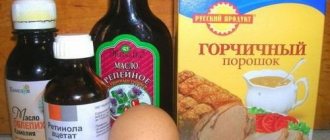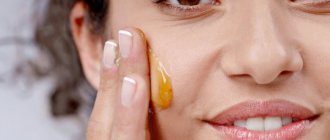White clay is a miraculous remedy in all areas of beauty; it is not without reason that it has been known since the times of the ancient Greek queens.
Expert opinion
Useful advice from the editor
By the way, don’t forget to also save yourself an interesting recipe for a white clay mask “Cleopatra’s Secret” for acne and inflammation on the face.
To this day, clay remains a universal natural medicine for all skin types and all ages. Kaolin goes well with herbs and oils, honey, lemon, grape and cucumber juice; it deeply cleanses and refreshes the face, smooths out wrinkles and effectively nourishes the skin.
Expert opinion
Useful advice from the editor
The use of white clay in cosmetology is discussed in more detail in the article: kaolin face masks for all skin types - be sure to read this review and the advice of our experts.
Today we will talk about the more specific use of white clay - against acne, post-acne spots, inflammation on the face and excessive oily skin, consider the best kaolin face masks, as well as reviews from our readers about the effectiveness of these recipes.
What are the benefits of white clay masks for problematic facial skin?
- Kaolin compares favorably with other types of clay in that it is suitable for all skin types - even thin, sensitive and prone to allergic reactions. Therefore, you can always choose a universal recipe depending on the individual characteristics of your body.
- White clay is rich in silica, zinc, magnesium and valuable mineral salts; it effectively softens and exfoliates dead skin, deeply nourishes it and makes it elastic, fights rashes and acne. At the same time, kaolin masks can be applied only to problem areas, which significantly saves product consumption.
- White clay evens out the complexion, lightens age spots and acne marks, in addition, kaolin tightens pores, gets rid of blackheads, relieves irritation and redness on the face.
- And finally, it is white clay in combination with other components that can smooth out fine wrinkles; With regular use, it eliminates sagging skin and promotes natural rejuvenation.
Why does white clay solve such a wide range of problems so effectively? Kaolin contains many minerals, trace elements and vitamins:
- Silicon is responsible for the production of collagen.
- Aluminum - dries out inflammation, fights acne.
- Manganese - controls sebum production.
- Zinc - works as an antiseptic.
- Calcium - promotes skin cell regeneration.
So, we offer you a selection of recipes for white clay masks for acne and other rashes on the skin of the face, while all the necessary ingredients can be collected at home.
Composition and properties
The composition of kaolin is very extensive and eliminates a wide range of problems and cosmetic defects.
Contains:
- Silicon – promotes exfoliation of dead epithelial particles;
- Magnesium – activates the synthesis of collagen, elastin and substances necessary to maintain skin turgor and moisture balance;
- Manganese - normalizes the production of sebum, removes particles of sebum, dead scales, and dirt from the pores;
- Aluminum – accelerates the restoration of tissues and cells, evens out skin tone.
Beneficial features:
- Giving the skin a healthy color;
- Soothing soreness, irritation and redness;
- Suppression of negative fungal activity;
- Dissolving sebaceous plugs;
- Making the skin matte;
- Formation of a clear oval face;
- Protection from the harmful effects of factors observed in places with unfavorable ecology - megacities, industrial cities;
- Removal of toxic substances from the skin layers;
- Possibility of use for sensitive and “capricious” dermis;
- Elimination of pain in inflamed areas.
Anti-acne mask with chamomile oil and white clay
What you will need:
- White clay (2 tablespoons);
- Green tea (1 tablespoon);
- Lemon essential oil;
- Chamomile oil.
Preparation of the mask:
Mix clay with green tea. If the consistency is too thick, add a little more green tea. If it’s the other way around, thicken the “porridge” with a pinch of kaolin.
Add 2 drops of lemon essential oil and 4 drops of chamomile oil.
Apply the mask to a previously prepared face for 15-20 minutes. If the clay begins to dry out in some places, and the procedure is still far from being completed, lightly moisten these areas with clean water.
Expert opinion
Useful advice from the editor
To get the maximum effect from the procedure, before applying the mask, it is recommended to warm your face over a steam bath or using a hot dry compress. To prepare them, it is recommended to use medicinal herbs: St. John's wort, chamomile, mint, yarrow, linden blossom or rose hips and sea buckthorn. For acne, it is advisable to alternate compresses with medicinal herbs with a steam bath.
The effect after a mask with oils and kaolin is noticeable almost immediately. After a month's course of such masks, pigment spots and red acne marks will completely disappear on your face. It is advisable to do the mask 2 times a week.
Contraindications to the use of clay
Cosmetic clay of any color in its natural pure form has virtually no contraindications. Difficulties may arise when mixing the powder with other components to which a person may have an allergic reaction. Therefore, before use, the prepared mass should be applied to a small area of the body, preferably on the elbow, and wait about 15 minutes.
If an area of the skin turns red, starts to itch, or feels a burning sensation, you should immediately wash off the mixture and cover the skin with a moisturizer.
And remember that you should use clay in the fight against acne marks regularly, from one to two to three months. I can tell you from experience: persistence and patience equal a good result.
Thank you for attention!
White clay and lemon mask for acne spots
Required ingredients:
- White clay (2 tablespoons);
- Egg white (1 pc.);
- Lemon juice (10-20 ml).
Preparation of the mask:
Dilute the clay with lemon juice, then add the protein and mix the mask well.
Apply the healing composition to the face and keep the mask until completely dry, then rinse with cold water.
The mask perfectly tightens the pores and draws out all the dirt from them. In addition, the composition mattifies the skin for the whole day, eliminates pigmentation and acne spots.
Feedback from our readers:
I liked the mask, but it is not suitable for daily care. It is better to use the recipe when necessary as an express remedy: for example, before going out. In addition, the mask works as a base for makeup.
Olga, 35 years old
Technology of use
The need to moisturize the skin after clay masks is a well-known fact. However, the face requires preparation before use. Basic principles that will help you use kaolin as efficiently and safely as possible:
- Face cleaning. Before applying any mask, your face must be cleansed. It is better to remove cosmetics with a soft toner applied to a cotton pad or a piece of cotton wool. After an active day, it is advisable to wash your face with foam, gel or special soap for washing. This will help thoroughly cleanse your facial skin of impurities after going outside or in the office.
- Regardless of which recipe is used, the clay for the mask must be sifted. This will make it easier to prepare the mixture.
- After applying the mask to your face, wash your hands thoroughly and ensure yourself a state of rest.
- For the clay to be effective, it must harden properly, so the muscles on the face should not move.
- Do not overexpose the mask. This is fraught with difficulties when washing it off and will lead to dry skin and irritation.
- Use running water to wash off the clay mask. You can take soft napkins, cotton wool or cotton pads. Do not use cosmetics or makeup removers.
White clay has proven itself as a good remedy for cleansing the skin of impurities, toxins, and sebum. It is famous for its ability to improve blood circulation, which leads to a reduction in the number of clogged pores. Today, white clay is one of the high-quality cheap products used in the fight against acne and their marks.
When using white clay for the face, blood circulation significantly improves. In almost every pharmacy you can buy powder or special ready-made preparations based on it. The benefits of white clay for acne spots are noted in scientific articles and in grateful user reviews. The mask is usually washed off only when it is completely dry.
Since combination skin types are most common, the mask dries more slowly on oilier areas of the face. In this case, you can apply a little water to areas that dry out faster. If your skin is prone to dryness, it is better to use clay no more than once a week. For normal and combination skin, 2 masks per week are recommended. If clay causes itching, flaking, irritation and excessive tightness of the skin, then you can add a couple of drops of olive oil to the mixture. It will moisturize the face and soften the effect of the clay.
Acne masks with honey and white clay
Natural flower honey is used in most homemade recipes for problematic facial skin. It has disinfecting and antimicrobial properties, promotes rapid healing of wounds and restoration of the skin.
Cleansing mask with honey and kaolin
The simplest recipe for oily skin with enlarged pores and acne consists of only two components:
- White clay;
- Natural flower honey.
To prepare the mask, mix equal parts of honey and white clay powder; if necessary, the composition can be diluted with fresh milk.
This recipe improves blood supply to tissues and effectively relieves inflammatory processes.
The exposure time of the mask is about half an hour; it is advisable to wash your face with a warm chamomile infusion.
Recipe with lemon juice and honey
You will need:
- 1/2 tsp. honey, glycerin and kaolin;
- 3 tsp freshly squeezed lemon juice;
- Some clean boiled water.
Mix all ingredients thoroughly and apply to prepared skin for a quarter of an hour. We wash ourselves first with warm, then with cold water.
Mask with white clay and mineral water
This is a “richer” recipe that is suitable not only for combating inflammation, but also age-related changes in the skin. This mask helps get rid of acne, heals wounds on the skin, and effectively softens and moisturizes the skin.
Required ingredients:
- White clay (2 tablespoons);
- Honey (1 tablespoon);
- Shea Butter;
- Mineral water.
Preparation of the mask:
- Melt honey in a water bath along with shea butter.
- Mix clay with water.
- Combine all ingredients and let the mask cool.
Apply the mask for 20-30 minutes, rinse with warm water. After the procedure, it is advisable to use a tonic.
Feedback from our readers:
Nice soft recipe. What is needed for problem skin after 35 years - the skin after the mask is soft, velvety, deeply moisturized. I’ll try to do the procedures regularly - they say that the skin smoothes out significantly after just 2 weeks. And small wrinkles disappear after 1.5 months.
Alina, 37 years old
Contraindications and harm
Kaolin is a component of natural origin, so in most cases its use is completely harmless. However, dermatologists and cosmetologists inform that there are situations in which white clay for post-acne and acne requires a careful approach:
- Increased body temperature;
- Tendency to allergic skin reactions;
- Excessive dryness of the skin - kaolin can be used, but with moisturizing components;
- Open wounds and injuries;
- Dermatological diseases in the acute stage.
For chronic diseases of the heart and blood vessels, it is important to obtain a doctor’s approval before starting treatment with white clay.
Other recipes with kaolin for problem skin
For oily, inflammation-prone skin, it is useful to wipe your face with a solution of:
- 50 gr. calendula infusion;
- 50 gr. water;
- 50 gr. camphor alcohol.
Badyaga, 3% hydrogen peroxide and Australian tea tree oil are also effective in the fight against acne.
White clay and tea tree oil
To prepare the mask, mix:
- 1 tsp talc;
- 1 tsp kaolin;
- 2-3 tsp. milk;
- a couple of drops of tea tree oil.
Apply the resulting mixture to the face and neck for 20 minutes, remove the mixture with a cotton swab moistened with cool water.
Pimples on the forehead: causes and treatment
Pimples on the forehead can appear for various reasons: from the use of comedogenic cosmetics, due to frequent rubbing with a hat, or taking certain medications48. Rashes can appear against the background of hormonal disorders, exacerbation of gastrointestinal pathologies48,49,80.
One of the drugs that can be used for mild to moderate acne is Azelik®5 gel. Its main active ingredient is azelaic acid5. The medicine must be applied to clean, dry skin twice a day5.
Customers' opinions
A lot of rave reviews can be heard about this natural substance. For example, Irina (25 years old), Khabarovsk: “Good basic recipes. The proportion is perfect. I use a mixture with the addition of cinnamon and honey, and I also add an egg yolk to the mixture. Smells great and leaves skin soft. The stains disappeared completely after the second application. I took a break of 1 day between masks. Now I apply it as a preventative for the skin once every 2 weeks (I don’t want to do it more often, it dries out my face too much). But the product only helps with acne spots. I treat the acne itself with medicinal ointments.”
Alena (38 years old), Krasnodar: “There was some blue clay left at home. I diluted it with water according to the recipe and added lemon juice. The skin was pleasantly smoothed and slightly brightened. Next time I bought white clay. The effect is the same. Despite the fact that they write about different types of clay, I didn’t notice any difference. In any case, the product is effective, the masks are pleasant for the face. I experiment with oils and herbs. Now I add clay to everything: masks, body scrubs, aromatic baths. The effect is superb, the main thing is not to forget about moisturizing the skin after the procedure.”
Vlada (18 years old), St. Petersburg: “I’m pleased with how the clay helps whiten the skin. I don't play much with masks. I simply dilute the powder with rose or lavender water, leave the mixture on for about 15 minutes. Then I apply a moisturizer with a floral scent. Wonderful home relaxation. I recommend".
Victoria (55 years old), Khabarovsk: “For many years I have been using clay (white or blue) in combination with other drugs to combat acne and skin redness. I dilute calendula in a decoction. Helps great. But this method does not suit my friend. Dries the skin too much and burns the face. Even good creams do not help with irritation. Therefore, if you have sensitive skin, it is better to buy ready-made clay-based preparations.”
Some women have been treated for acne for a long time, but after such procedures they are left with large red spots from acne. On the advice of friends and pharmacists, they buy simple white clay. They note that it is very difficult to achieve the desired consistency when mixing a substance with water: sometimes the mixture is too liquid, sometimes too thick. Rose oil is added for scent and beauty.
One customer reported that her skin felt too tight after applying the mask, even though she kept the mixture on her face for 10 minutes. This substance is not ideal for everyone, so fewer women note the appearance of an unpleasant sensation all day, after which the spots do not disappear but remain in place. No cream saved them from the resulting irritation, but the drug Panthenol helped a little.
Different results
There may be several reasons for obtaining different results: either too sensitive skin or bad clay. For those who have suffered a similar unfortunate result, such women give advice: you should mix the juice of 1 cucumber (homemade or purchased at the market) with 2 tsp. lemon juice and honey and wipe your skin with it. A couple of pieces of the vegetable should be applied to the areas of redness. Within a few days of daily use, the stains disappear almost completely.
Olesya from Pskov also confirms the effectiveness of the above. She always has healing clay at home (she buys it at the pharmacy), as it is an excellent base for any mask. Mixes the substance with calendula and chamomile infusion, even with cucumber juice and mashed avocado. To avoid skin problems after the procedure, she pays special attention to the epidermis after the mask. To do this, the girl first runs an ice cube over her face, and then uses a nourishing cream. And then the result will not be long in coming. A girl wakes up with fresh and soft skin.
But Kristina from Omsk tried to make a mask with grape juice and herbal decoction. Very pleasant and soothing aroma. The clay dried out and tightened the skin. But the slight redness of the skin did noticeably lighten. Next time she wants to try different consistencies and will use less clay.
The girl discovered a high-quality and cheap way to care for the beauty of her skin. She was pleased. She soothes her face with ice, but freezes not water, but a herbal decoction. Brews mint with linden and currant berries. After this, it needs to be cooled and poured into molds. The product perfectly refreshes the skin and relieves irritation.
Clay is a wonderful base for masks. Don't forget about aloe. Many people make a mask from its juice, mixing it with white and blue clay.
This mass evens out the complexion and rejuvenates the skin. For those whose epidermis is very dry from white and blue clay, pharmacies sell a red variety of the substance. Scrubs are made on its basis, but in this case other shades should be abandoned.
Almost all mask recipes are good, but it is also important to understand which clay is best to choose. For example, all the masks from the Indian supply turned out good and pleasant. But there are also fakes, after which you don’t feel the effect, and the consistency comes out strange. A pack of domestically produced clay costs much less, but the results are wonderful.
People suffer for a long time with acne and pimples on their faces. They visit both cosmetologists and nutritionists, and when they get rid of the formations, most often spots remain on the face. After using different combinations, the spots in most cases disappear after 2 weeks (about 4-5 masks), but the skin becomes very soft. In addition, such clay masks can be made once a week as a facial treatment.











